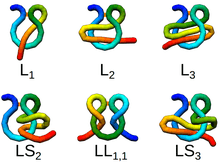Complex lasso proteins
Complex lasso proteins (also called pierced lasso bundles or tadpoles) are proteins in which a covalent loop (portion of the backbone closed with a covalent bridge) is pierced by another piece of the backbone. Subclass of complex lasso proteins are Lasso peptides in which the loop is formed by post-translational amide bridge[1][2].
Classification of complex lassos

Complex lassos can be divided according to the number of piercings through the minimal surface spanned on the covalent loop[4][5]. In particular, four classes of complex lasso proteins exist:
- the Ln class (simple lasso), where one tail pierces the surface n times;
- the LSn class (the supercoiling lasso), where one tail pierces the surface n times, winding around the loop;
- the LLi,j class (double lasso), where both tails pierce the surface i and j times respectively;
- the LSLi,j class, where one tail pierces the surface i times in the supercoiling manner, and the second pierces the surface in the simple manner.
Another classification may be given according to the nature of the bridge closing the covalent loop. Most of the complex lasso proteins have a disulfide-based loop, however, the amide-based (lasso peptides) and ester-based complex lasso proteins are known.[5]
Popularity of complex lasso in proteins
Around 18% of proteins with disulfide bridges have complex lasso[4][5], however, much more complex lasso would be predicted when analyzing the non-interacting polymeric models [6]. Apart from structures with only one pierced loop, there may be also chains with several complex lasso structures. In particular, the loops may pierce each other, forming a protein Hopf link[7]. There are much less complex lassos in proteins than it is expected from simple polymer models. However, there are groups of proteins which have higher complex lasso probability than we could expect from such models.
Biological role
It is not known if the complex lasso motif is functional in general. However, in some cases the importance of the motif for the protein function was reported. In particular, in case of lasso peptides, the motif allows to act like a plug for specific NTP-uptake channels.[8][9][10]. On the other hand, the motif was shown to be functional in case of leptin - the obesity-related protein [11]. The analysis of the shape of complex lasso proteins compared to the polymeric models with similar size shows, that some classes of complex lasso proteins may also be functional. This concerns toxic, antimicrobial, defensin-like or immune system related with L1 motif[6]
Computer tools to analyze the complex lasso topology
The current list of complex lasso proteins may be found in the LassoProt database[5], which allows also uploading and analyzing own data. The manual inspection of the data is also possible with the PyLasso[12] - the PyMol plugin.
See also
References
- Li, Yanyan; Zirah, Séverine; Rebuffat, Sylvie (2015). Lasso Peptides. SpringerBriefs in Microbiology. New York, NY: Springer New York. doi:10.1007/978-1-4939-1010-6. ISBN 9781493910090.
- Maksimov, Mikhail O.; Pan, Si Jia; James Link, A. (2012). "Lasso peptides: structure, function, biosynthesis, and engineering". Natural Product Reports. 29 (9): 996–1006. doi:10.1039/c2np20070h. ISSN 0265-0568. PMID 22833149.
- Dabrowski-Tumanski, Pawel; Sulkowska, Joanna (2017-09-16). "To Tie or Not to Tie? That Is the Question". Polymers. 9 (12): 454. doi:10.3390/polym9090454. ISSN 2073-4360. PMC 6418553. PMID 30965758.
- Niemyska, Wanda; Dabrowski-Tumanski, Pawel; Kadlof, Michal; Haglund, Ellinor; Sułkowski, Piotr; Sulkowska, Joanna I. (2016-11-22). "Complex lasso: new entangled motifs in proteins". Scientific Reports. 6 (1): 36895. Bibcode:2016NatSR...636895N. doi:10.1038/srep36895. ISSN 2045-2322. PMC 5118788. PMID 27874096.
- Dabrowski-Tumanski, Pawel; Niemyska, Pawel; Pasznik, Pawel; Sulkowska, Joanna I. (2016-04-29). "LassoProt: server to analyze biopolymers with lassos". Nucleic Acids Research. 44 (W1): W383–W389. doi:10.1093/nar/gkw308. ISSN 1362-4962. PMC 4987892. PMID 27131383.
- Dabrowski-Tumanski, Pawel; Gren, Bartosz; Sulkowska, Joanna I. (2019-04-17). "Statistical Properties of Lasso-Shape Polymers and Their Implications for Complex Lasso Proteins Function". Polymers. 11 (4): 707. doi:10.3390/polym11040707. ISSN 2073-4360. PMC 6523798. PMID 30999683.
- Dabrowski-Tumanski, Pawel; Sulkowska, Joanna I. (2017-03-28). "Topological knots and links in proteins". Proceedings of the National Academy of Sciences. 114 (13): 3415–3420. doi:10.1073/pnas.1615862114. ISSN 0027-8424. PMC 5380043. PMID 28280100.
- Knappe, Thomas A.; Linne, Uwe; Zirah, Séverine; Rebuffat, Sylvie; Xie, Xiulan; Marahiel, Mohamed A. (August 2008). "Isolation and Structural Characterization of Capistruin, a Lasso Peptide Predicted from the Genome Sequence of Burkholderia thailandensis E264". Journal of the American Chemical Society. 130 (34): 11446–11454. doi:10.1021/ja802966g. ISSN 0002-7863. PMID 18671394.
- Pan, Si Jia; Link, A. James (2011-04-06). "Sequence Diversity in the Lasso Peptide Framework: Discovery of Functional Microcin J25 Variants with Multiple Amino Acid Substitutions". Journal of the American Chemical Society. 133 (13): 5016–5023. doi:10.1021/ja1109634. ISSN 0002-7863. PMID 21391585.
- Hegemann, Julian D.; Zimmermann, Marcel; Xie, Xiulan; Marahiel, Mohamed A. (2015-07-21). "Lasso Peptides: An Intriguing Class of Bacterial Natural Products". Accounts of Chemical Research. 48 (7): 1909–1919. doi:10.1021/acs.accounts.5b00156. ISSN 0001-4842. PMID 26079760.
- Haglund, Ellinor; Pilko, Anna; Wollman, Roy; Jennings, Patricia Ann; Onuchic, Jose Nelson (2016-12-30). "Pierced Lasso Topology Controls Function in Leptin". The Journal of Physical Chemistry B. 121 (4): 706–718. doi:10.1021/acs.jpcb.6b11506. PMID 28035835.
- Gierut, Aleksandra M; Niemyska, Wanda; Dabrowski-Tumanski, Pawel; Sułkowski, Piotr; Sulkowska, Joanna I (2017-12-01). Valencia, Alfonso (ed.). "PyLasso: a PyMOL plugin to identify lassos". Bioinformatics. 33 (23): 3819–3821. doi:10.1093/bioinformatics/btx493. ISSN 1367-4803. PMID 28961868.